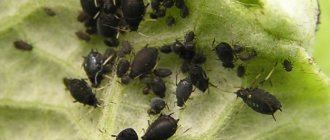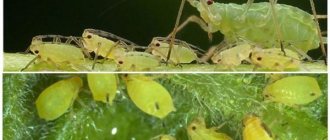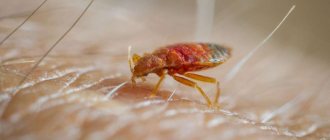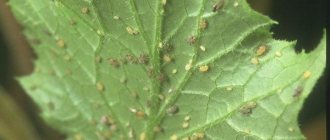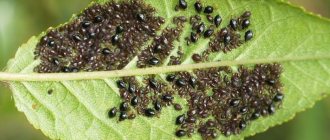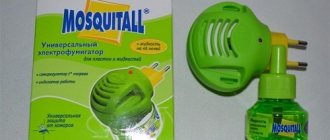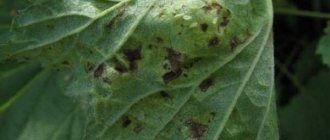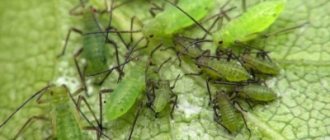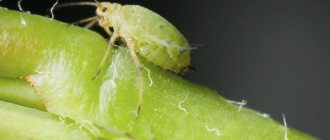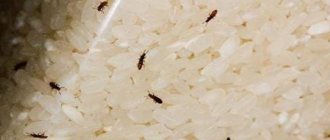The melon aphid affects many agricultural crops, in particular tomatoes. Settling on the underside of the leaves, the insect sucks out all the juices from the young leaves, as a result of which the plant dies.
Once on a tomato bush, aphids quickly spread throughout the entire garden bed, giving neither young nor mature tomatoes a chance to survive.
What kind of pest is this
The melon, or cotton, aphid belongs to the class of insects, the family True aphids.
This type of aphid infects more than 330 plant species: cucumbers, watermelons and melons, pumpkin, cotton, tobacco and others.
In weather conditions in the middle zone, it becomes active in the first half of July. In greenhouses, cucumbers can be attacked by the pest as early as mid-May.
The parasite is widespread everywhere.
What does it look like
The size of the insect is 3-4 mm. The body of the melon aphid is elongated, pointed towards the rear tip. The body is colored in different shades of green, the legs and antennae are dark brown or black. There are winged and wingless individuals.
The oral apparatus is of a sucking type, equipped with a proboscis, with the help of which the insect pierces the plant tissue and sucks out the cell sap.
Our photos will help you identify the pest.
How does it reproduce
In the spring, the colony begins with larvae. They hatch from eggs laid on weeds in the fall at an air temperature of +5ºC. The larvae are able to overwinter under the leaves of winter-green plants, for example, in greenhouses.
After molting, the larvae transform into wingless females and begin asexual reproduction.
As the colony becomes denser, winged individuals appear, which fly and are carried by the wind to neighboring plants, where they form new colonies.
During the summer, dozens of generations of females are born, the offspring from one larva reaching tens of thousands of individuals.
In autumn, winged males emerge and fertilize females, who again lay eggs. It is these offspring that are able to survive the winter and begin the next life cycle.
How to recognize damage to cucumbers by melon aphids
On cucumbers affected by aphids, the leaves droop, curl, and fade. Flowers and ovaries fall off.
On the back of the leaves, small insects and a shiny thin film of sugary waste products of aphids are visible. As the colony grows, insects settle on stems, buds and young shoots.
Damage caused
Parasites pierce cucumber leaves with their proboscis and feed on their juice. The leaf blade wrinkles and dries out. The processes of photosynthesis and the formation of nutrients are inhibited. Fruit growth and formation slow down.
If uncontrolled reproduction, an aphid colony can lead to the death of the plant and complete loss of the harvest.
In addition, aphids transmit viral diseases, so the pest invasion is often accompanied by outbreaks of cucumber mosaic.
Signs of aphids on tomatoes
Aphids enter tomato plantings in different ways: through weeds, purchased seedlings, soil, and insects. With the onset of warm weather, females begin to reproduce, forming a large colony.
Melon is located on the underside of leaves growing on young stems and shoots. Symptoms of aphids on tomatoes:
- curling, drying out of young foliage;
- a sticky whitish coating appears on the shoots - waste products of the pest;
- the tomato bush stops growing;
- There are a lot of ants in the garden bed.
If you examine the leaf blade, you will notice a dark teeming mass - this is a rapidly reproducing aphid. By sucking plant juices, it disrupts the process of photosynthesis in plants. But besides this, aphids poison the plant with toxins. Because of this, the plant cannot consume nitrogen in proper quantities. The tomato bush becomes weak and vulnerable. Leaves and shoots become deformed, dry out, fruits become small and clumsy. Their taste spoils.
How to fight
It is not difficult to destroy aphids; the insect is susceptible to the action of various drugs.
There are two rules for a successful fight:
- Simultaneously with the destruction of the parasite, take measures to eliminate the ants.
- Treatment with any means should be carried out not only from the top, but also from the bottom side of the sheet.
Chemicals
Insecticides have a powerful effect against aphids:
- "Metaphos" is a contact action drug. The active ingredient is parathion-methyl. Available in the form of an emulsion in ampoules of 5 ml. To prepare the working solution, the contents of 2 ampoules (10 ml) are diluted in 10 liters of water. Treatment is carried out in the early morning or evening. The last spraying is no earlier than 30 days before harvesting the fruits.
- "Decis Lux" is an emulsion of contact-intestinal poison based on deltamethrin. Packaged in ampoules or bottles of various sizes. To treat cucumbers, 5 ml of the drug is dissolved in 20 liters of water. Cucumbers are sprayed when the first specimens appear, and when they appear again - after 2 weeks. The waiting period before harvesting is 20 days.
- "Inta-Vir" is a chemical of contact-intestinal action. The main substance is cypermethrin. It is produced in the form of tablets weighing 8 g. To combat aphids, dilute 1 tablet in 10 liters of water. Processed during the growing season at least 20 days before harvesting cucumbers.
Important! When working with chemicals, you need to wear closed clothing, a hat, gloves and a respirator. After work, be sure to wash your hands and face with soap and wash your clothes.
Biological products
Biological products are less toxic to humans and beneficial insects. They have a delayed effect; the death of parasites occurs 1-3 days after treatment.
Among such products, “Fitoverm” and “Aktofit” are popular among vegetable growers, which have a nerve-paralytic effect on pests.
| A drug | Active substance | Preparation of working solution | Frequency of treatments | Consumption rate | Waiting period |
| "Fitoverm" | 5% aqueous emulsion of aversectin C | 2 ml per 1 liter of water | 1-2 with an interval of 2-3 weeks | 100 ml per 1m² | 1-3 days |
| "Aktofit" | 0.2% alcohol solution of aversectin C | 8 ml per 1 liter of water | 1-2 with an interval of 2-3 weeks | Until the sheet is completely wetted. When drops of liquid drain, transfer the stream to another surface to be treated. | 2 days |
Reference. The standards for preparation and consumption of solutions are given for the control of aphids on cucumbers. When using drugs on other crops or against other pests, you should carefully read the instructions.
Folk remedies
Budgetary folk remedies against melon aphids on cucumbers are good as a preventive measure and in the initial stages of infection. The most common recipes:
- Shag or tobacco. Pour 300 g of dry shag (tobacco) into 10 liters of water, leave for 2 days, strain before use and add 70 g of grated tar soap.
- Vinegar. 7 tbsp. l. Dissolve 9% vinegar in a bucket of water.
- Hot pepper. Grind 50 g of red hot pepper pods, pour in a liter of boiling water and leave for 2 hours, strain and dilute with 10 liters of water.
- Celandine. Pour 200-300 g of dry herb into a bucket of water and leave for a day, strain before use.
- Garlic. Chop 500 g of garlic, add 3 liters of water and leave in a dark place for 5 days. To prepare the working solution, take 50 ml of infusion per 10 liters of water.
- Ash and laundry soap. 50 g of wood ash and 70 g of grated laundry soap are mixed with 10 liters of water.
Vegetables are sprayed with one of the listed products until the pest completely disappears at intervals of 7 days. The optimal consumption is 1 liter per 10 m2.
Plants that repel pests
To create a natural barrier against aphids, fragrant plants are planted next to the cucumber beds: garlic, marigolds, cilantro, fennel, basil, thyme, peppermint.
Prevention measures
You can avoid the appearance of insects on tomatoes by applying timely protective measures.
Seasonal preventive manipulations:
- In the fall, after harvesting, it is necessary to thoroughly clear the ground of plants in which pests are hiding. The soil needs to be dug deep - this way you can destroy the egg laying in the soil spores;
- In the spring, before planting seedlings in the garden, the ground must be treated with insecticides such as Karbofos (60 grams per bucket of water). Moreover, the frame and walls of the greenhouse are disinfected - all surfaces are washed with a manganese solution or treated with copper sulfate.
- Along the tomato beds, along with the seedlings, fragrant plants are planted that repel insects - marigolds, lupine, dandelion, wormwood, dill, celery.
- Anthills found on the site must be moved outside the site.
- Tomato bushes should be regularly inspected for pests. If lesions are found, it is better to remove them from the plant.
By the way!
Aphids are attracted to plants such as viburnum, nastrutia, cosmos, begonia, poppy, linden, and mallow. Therefore, tomato beds should not be placed next to these bushes.
Preventive measures
The risk of aphids is significantly reduced with proper care of vegetables, so it is important to follow the watering and fertilizing regime.
The following measures have a preventive effect:
- Ant population control. To combat ants, the drugs “Absolut”, “Aardeater”, “Grom-2” and others are used.
- Disinfection of soil and greenhouse structures with bleach (400 g per 10 liters of water) before planting vegetables.
- Thorough removal of all plant debris from the beds. Aphid larvae can survive on weeds and tops remains.
- Compliance with planting schemes: no more than 4 cucumber bushes are planted per 1 m2. Density promotes the rapid spread of pests.
- Regular inspection of plants. Weekly inspection of leaves allows you to detect pests earlier and begin timely control.
Morphologically related species
In terms of external characteristics (morphology), the buckthorn aphid (Aphis frangulae) is close to the described species. In winged insects, they are distinguished by the presence on the third segment of the antennae (or antennae, or situs) - a pair of movable jointed appendages of the insect's head, extending from the front surface, usually between the eyes.
More details by following the link
More details by following the link
More details by following the link
“>The abdomen sometimes shows marginal tubercles.
In addition to the described species, Aphis galiiscabri and Aphis hieracii, also morphologically similar to the melon cotton aphid (Aphis gossypii), are often found.
Tips and tricks
Experienced vegetable growers recommend planting varieties and hybrids with complex disease resistance. They are distinguished by a strong root system, powerful vegetation and recover faster from pest attacks. It is worth paying attention to the hybrids Murashka F1, Boy with Thumb F1, Masha F1, Pasadena F1.
To combat the parasite, it is useful to attract birds and insects that eat aphids to the site. To attract sparrows, tits, and linnets, feeders are hung around the garden plot.
Planting dill and mustard next to cucumber beds will attract ladybugs - natural enemies of aphids.
Insecticides
If insecticides are used to control melon aphids, care should be taken to thoroughly cover the foliage of the plant. Leaf distortion caused by aphid feeding provides excellent cover for insects, so systemic insecticides are useful. Early in the season, aphid infestations are often localized, and if such plants or areas are treated promptly, much damage can be prevented this season. Using insecticides on other, more harmful insects sometimes results in melon aphid outbreaks. However, melon aphid resistance to chlorinated hydrocarbons, organophosphates, and pyrethroid insecticides is widespread.
